Key points
- Hydrangeas (Hydrangea spp.) are popular flowering shrubs in Maryland gardens that are easily recognizable by their big blue, pink or white flower heads.
- The ‘showy’ part of many hydrangea blooms have sterile flower parts that do not provide the pollen necessary to support pollinators. The fertile flower parts are much smaller, less showy, and do support pollinators.
- Pruning at the wrong time of year for the variety of hydrangea is the most likely reason that hydrangeas fail to bloom. Follow the hydrangea pruning web page information.
Growing hydrangeas in Maryland
- There are many varieties of hydrangea that grow and thrive in Maryland, each comes with a different set of growing requirements. Don’t assume that their requirements are interchangeable.
- Smooth hydrangea (Hydrangea arborescens) and Oakleaf hydrangea (Hydrangea quercifolia) are native species.
- Plant labels may say hydrangeas can take full sun. But planted in full sun, they will require more water and the bloom period may be reduced. Sunburn on the foliage and blooms is also possible since several species are adapted to woodland habitats".
- Most plant problems can be avoided by providing plants with what they need to thrive, not just survive.

Smooth hydrangea (Hydrangea arborescens)
- Native to the eastern United States, including Maryland.
- Prefers moist, rich soils in partial sun or shade.
- Flowers appear in June and are typically white, though some pink cultivars have recently been introduced. Many flowers are green when they begin to open. A second flush may appear in August or September.
- Blooms on the current season’s growth (new wood)
- Visiting insects (faunal associations) | Illinois Wildflower Association

Oakleaf hydrangea (Hydrangea quercifolia)
- Large white blooms late June - July on the previous season’s wood (termed “old wood”). The blooms of some cultivars age to pink.
- Prefers partial shade in moist soil.
- Prune immediately after flowering, if needed.
- Renewal prune old or weak stems, to keep growth under control and rejuvenate the shrub.
- This species tends to reliably display showy fall foliage colors like plum-red, burgundy, scarlet, and orange, unlike many other hydrangeas.
- Native to the Southeastern US, though not into Maryland.

Bigleaf hydrangea (Hydrangea macrophylla)
- Bloom time is from mid-June into August. The flower color palette of this group is the most diverse of all the hydrangeas, from white to various shades of pink, rosy near-red, purple, and true blue.
- Blooms appear from buds from the previous season’s growth (old wood).
- Deer browse plus extremely cold low temperatures, periods of drought, late frosts, or other weather extremes can result in the death of overwintering flower buds. For cultivars that cannot rebloom, this prevents flowering the following summer.
- Soil acidity (pH) affects the flower color of most cultivars except those with white flowers. Acidic (low pH of 5.0 - 5.5) soils will produce blue flowers. Use sulfur or iron sulfate to lower the soil Ph instead of aluminum sulfate (AS). Too much (AS) can damage or burn roots causing plant damage.
- Slightly acidic or alkaline soils (pH of 6.0 - 6.5) will produce flowers in the pink range. Purples or all three colors are possible in-between.
- Prefers rich, well-drained soil in part sun to part shade.
- Requires regular watering in dry weather. Mulching helps to maintain soil moisture, especially in full sun. This species may wilt when daytime temperatures are high, even if the soil is sufficiently moist, especially if the plant is in full sun. If plants recover at night and the soil isn’t dry, heat stress is the cause and supplemental watering is not needed.
- Cultivars of bigleaf hydrangea are available that are more winter hardy, have longer blooming periods due to the ability to re-bloom, larger flowers, different shaped blooms, and other desirable characteristics. New cultivars are frequently introduced into the nursery trade every growing season.

Panicle hydrangea (Hydrangea paniculata)
- Blooms on new wood starting in mid-July. Flowers are largely white, though some forms begin lime-green and others age to pink, though the richness of the pink color may depend on cooler temperatures.
- Prune in winter or early spring.
- Prefers rich, loamy, well-fertilized soil in full sun to partial shade.
- Mulch around the base of the plant to help to maintain moisture.
- H. paniculata 'Grandiflora' is an old cultivar that gives the group its other common name, PeeGee or P.G. hydrangea.



